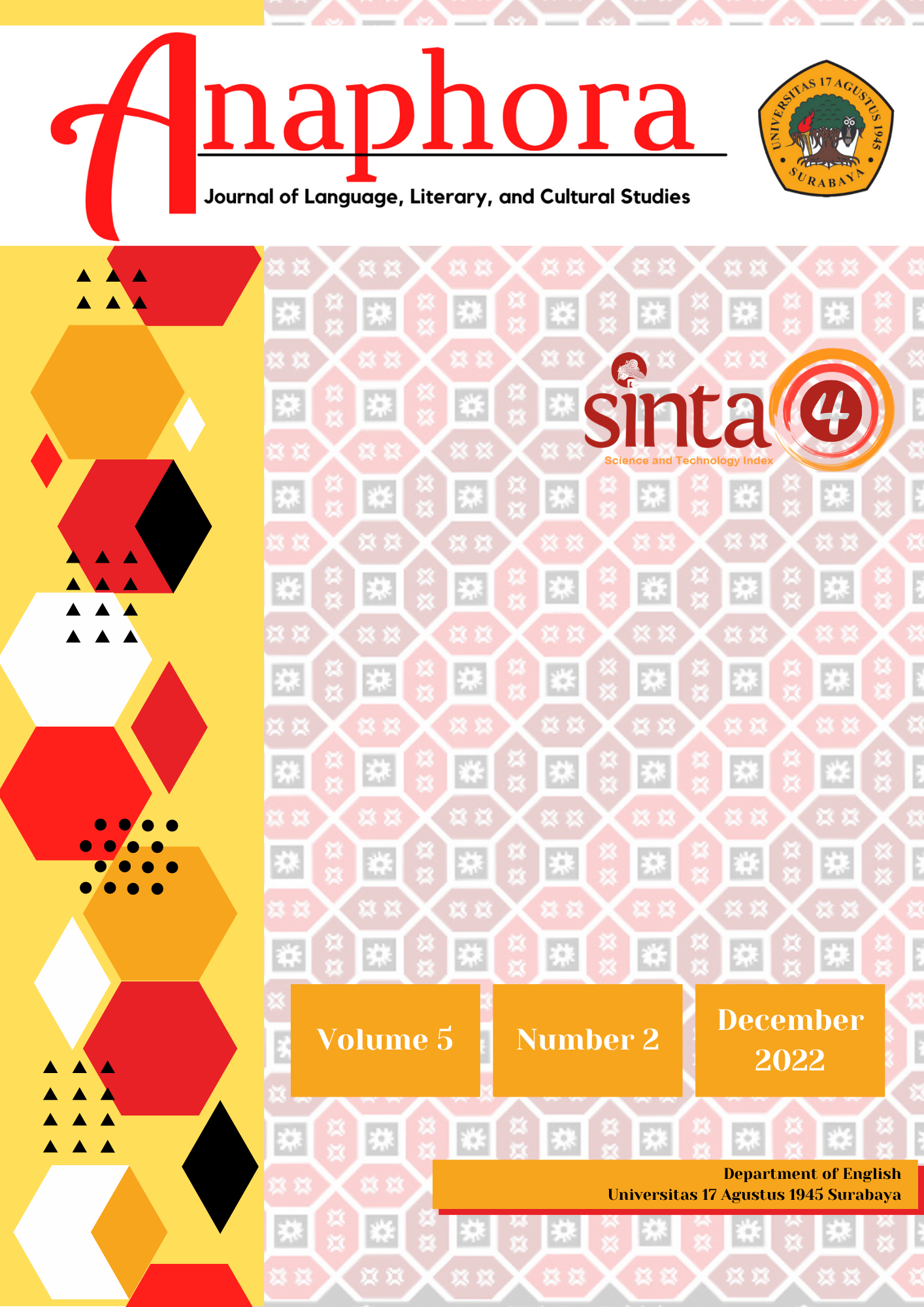Conceptual Metaphors in A Collection of Cirebon Folklore by Made Casta and Masduki Sarpin
Abstract
This research is motivated by themetaphorical language that often appears in literary works because literary works contain many connotative meanings, so they use majas. One of the literary works is folklore. In this study, researchers were interested in analyzing conceptual metaphors found in several folklore. The source of the research used is based on a collection of folklore entitled "Folklore from Cirebon" by Made Casta and Masduki Sarpin published in 1998. That way, the purpose of this study is to describe the types of metaphors, conceptual meanings, and image schemes in the cirebon folklore collection. This research uses descriptive qualitative methods. The data collection technique in this study is a reading and note-taking technique, namely by reading the book of the collection of folklore, then recorded and classified the type of metaphor obtained. The data analysis techniques used are analysis techniques according to Miles and Huberman (1992), namely: (1) data reduction (data reduction), (2) data presentation (data display), and (3) conclusion drawing. From the research, the results were obtained, namely from the 6 folklore analyzed, there were 14 data that contained metaphorical meanings. The metaphor is based on three types of metaphors, namely structural, orientational, and ontological. The results stated that this collection of folklore from Cirebon uses the most orientational metaphors with the image scheme that appears the most is the spatial image scheme. Both metaphors and image schemes are found in many folklore entitled The Origin of the Name Cirebon. This research is expected to be useful for literature learning in high school and for the advancement of conceptual metaphorical research.
Downloads
References
Apriliani, L. P. M., Pebryani, N. D., & Diantari, N. K. Y. (2022). Anggaraksa Sidhi Gama Dhanda: Metafora Selat Bali dalam Busana Casual Feminim. BHUMIDEVI: Journal of Fashion Design, 2(1), 84-91.
Arimi, Sailal. (2015), Cognitive Linguistics an Introduction. Yogyakarta: A. Com Advertising.
Aulia, Z. N., & Nur, T. (2020). Metafora Konseptual dalam Rubrik Unak-Anik Kahirupan Majalah Online Manglé : Analisis Semantik Kognitif. Lokabasa, 11(2), 226–236. https://doi.org/10.17509/jlb
Dessiliona, Tryta., Nur, T. (2018). ( Conceptual Metaphor in Songs Lyric Revolverheld Band Album in Farbe ). Sawerigading, 24(2), 177–184.
KBBI V Online. kbbi.kemdikbud.go.id.
Lyra, H. M., Sobarna, C., Djajasudarma, F., & Gunardi, G. (2016). Citra Haté “Hati” dalam Metafora Orientasional dalam Bahasa Sunda. Metalingua, 14(2), 167–176. http://metalingua.kemdikbud.go.id/jurnal/index.php/metalingua/article/view/193/92
Miles, M.B and Huberman, M. (1992). Qualitative Data Analysis. Jakarta: University of Indonesia Publishers.
Nugrahani, F., & Hum, M. (2014). Metode penelitian kualitatif. Solo: Cakra Books, 1(1).
Pirmansyah, P., & Nur, T. (2021). METAFORA KONSEPTUAL DALAM AL-QURAN SURAT YASIN: KAJIAN SEMANTIK KOGNITIF. Jurnal Perspektif, 5(2), 146-160.
Restiani, A., & Nur, T. (2019). Konseptualisasi Metafora Pada Lagu Coldplay Dalam Album “a Head Full of Dreams”: Kajian Semantik Kognitif (Metaphorical Conceptualization in Coldplay Album of a Head Full of Dreams: a Cognitive Semantics Study). Metalingua: Jurnal Penelitian Bahasa, 17(1), 13. https://doi.org/10.26499/metalingua.v17i1.223
Santoso, T., & Wahyu Riani, R. (2019). Makna Metafora Idiom (Kanyouku) Dalam Unsur Mata (Me): Sebuah Kajian Linguistik Kognitif. Journal of Japanese Language Education and Linguistics, 3(1), 35–55. https://doi.org/10.18196/jjlel.3123
Selat, M., Dalam, B., & Cassual, B. (2022). ANGGARAKSA SIDHI GAMA DHANDA : METAFORA SELAT BALI. II(1), 84–91.
Subhan, R. F., Nur, T., & Nugraha, T. C. (2019). KONSEPTUALISASI SIFAT DAN PERBUATAN DALAM METAFORA BERUNSUR TUBUH “TANGAN” PADA ALQURAN (Trait and Action Conceptualization in Metaphor of “Hand” at The Koran). Kandai, 15(1), 61. https://doi.org/10.26499/jk.v15i1.1287
Sugiyono. (2012). Educational Research Methods: Quantitative, Qualitative, and R&D Approaches. Bandung: Alfabeta.
Susanto, S. (2020). Metafora kepemimpinan masa pandemi dalam Cerita Legenda Datuk Marsam Sang Belalang Kunyit. In Prosiding Seminar Nasional Bahasa dan Sastra Indonesia (SENASBASA) (Vol. 4, No. 1).
Widiasri, F. S., & Nur, T. (2021). Metafora Konseptual Dalam Rubrik Teknologi Koran Elektronik Kompas. Kajian Linguistik Dan Sastra, 5(2), 137–144. https://doi.org/10.23917/kls.v5i2.11057
Yi, M. (2020). METAFORA ENTITAS AIR DALAM CERITA RAKYAT JAWA TIMUR. (Skripsi). Universitas Negeri Yogyakarta, Yogyakarta.
Copyright (c) 2022 Afina Naufalia, Tajudin Nur, Sutiono Mahdi, Agus Suherman Suryadimulya

This work is licensed under a Creative Commons Attribution-ShareAlike 4.0 International License.
Authors whose manuscript is published will approve the following provisions:
-
The right to publication of all journal material published on the jurnal anaphora website is held by the editorial board with the author's knowledge (moral rights remain the property of the author).
-
The formal legal provisions for access to digital articles of this electronic journal are subject to the terms of the Creative Commons Attribution-ShareAlike (CC BY-SA) license, which means Jurnal Persona reserves the right to store, modify the format, administer in database, maintain and publish articles without requesting permission from the Author as long as it keeps the Author's name as the owner of Copyright.
-
Printed and electronic published manuscripts are open access for educational, research and library purposes. In addition to these objectives, the editorial board shall not be liable for violations of copyright law.




